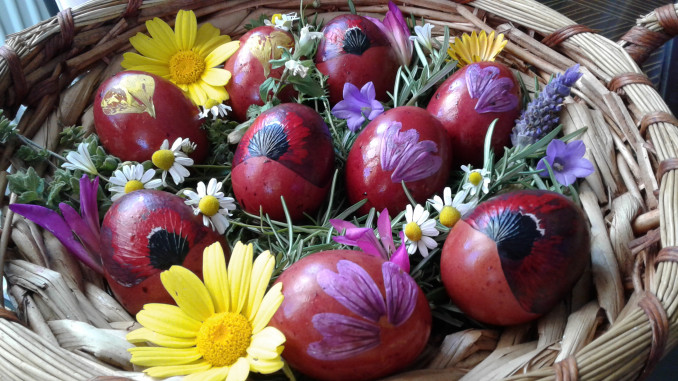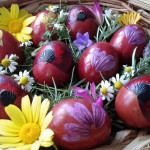
Easter Customs in Greece
Easter is celebrated all over the mainland and on the islands, it is a family celebration as well as being the most significant time in the Greek Orthodox Church. For the church it is a celebration of the death and resurrection of Christ, and also dating from ancient times it marks the changing seasons and the arrival of spring. The date of Easter in Greece is marked by the Grecian calendar and so does not fall at the same time as Easter in other European countries.
The Holy Week, or Easter week, including Good Friday, Easter Sunday and Easter Monday are all public holidays in Greece. Families get together and people enjoy a holiday air, and there are many wonderful food traditions that Greeks follow around Easter time.
Tradition #1: Baking Tsoureki & Dying Red Eggs
On Thursday evening, all of the Greeks prepare for the Holy Weekend. Everybody makes the delicious sweet Easter bread, called Tsoureki (or buys it from the bakery because it’s very difficult). This is eaten on Easter as the three braid of the bread represent the Holy Trinity. Many people even cut into the shape of a cross. Additionally, eggs are being boiled and dyed red. (See Tradition #4 to learn more about the importance of the Red Eggs.)
Tradition #2: Church Bells, Flags, Tomb of Jesus
On Good Friday, there is a sombre atmosphere and the church bells ring and flags fly half mast, and in some villages a shrine representing the tomb of Jesus is carried in the streets. This sad mood is soon broken in true Greek style, with lots of eating and singling and loud noise.
Tradition #3: Midnight Church Service & Candles
Late on Saturday night, before midnight all the people go to all the churches, which all seem full to bursting. Then follows a festival of light that is a true delight – at midnight the church goes dark and the bells ring out to proclaim the resurrection, and people start cheering and letting off fireworks and crackers! The Greeks young and old buy or make their own Easter candles which they take to the church on this night. The priest lights a candle representing of Jesus’ eternal flame and everyone lights their candle from this one. People carefully carry their candle home and make a black cross on their house with the flame to bless themselves.
Tradition #4: Red Egg Cracking
Afterwards, they return to their homes and the families sit together at the table to have the festive dinner! They always start with cracking the red eggs with each other, which symbolizes the risen Christ’s blood. Everyone selects one egg, carefully choosing the one that seems the strongest. Then the egg cracking begins! One cracks their chosen egg on top of another’s chosen eggs, saying “Christos Anesti” (meaning “Christ has risen”). The other one responds, “Alithos Anesti” (meaning “Indeed, he did!”). Each time there is a winner and loser. Loser is obviously the one with the cracked egg. The egg cracking keeps on going, until there is only one winner- the chosen one with the un-cracked egg! The one with the strongest egg is said the have good luck for the whole year
Tradition #5: Eating Magiritsa
After the egg cracking, they start eating the traditional magiritsa! This dish contains the offal of the lamb just before it is roasted, along with some green vegetables (lettuce, dill and onion) boiled together. It is traditional to eat magiritsa because it symbolizes the end of the 40-day fast Greek Orthodox people have right before this day in order to mourn the death of Jesus. This feast of drinking and eating lasts till the early hours, sleeping only to get up and make the Easter Sunday lunch.
Tradition #6: Roasting the Lamb
The Easter Sunday is another day to celebrate. Families gather again before noon to roast the lamb on a spit and then enjoy a long lunch with lots of meat, potatoes, salads and drinks. Don’t you remember in My Big Fat Greek Wedding, “What do you mean he don’t eat no meat? Okay. It’s okay. I cook lamb.” If you don’t remember, watch the scene here.
Καλό Πάσχα!
Happy Easter!


